Today’s families are increasingly reliant upon working mothers as breadwinners or co-breadwinners. (see Figure 1) The past four decades have brought about dramatic changes in how women—and men—navigate their workplace responsibilities, caregiving needs, and personal lives. Four in five U.S. families with children are headed by either two working parents or a single working parent, and thus most families have to navigate issues such as costly or inadequate child care, a lack of paid family leave, and the persistent wage gap, just to name a few.
While social and economic changes created this new reality, political decisions have shaped the struggles so many families now face. All working women deserve a fair day’s pay, but they also need to have time to actually live their lives and do what is important to them without fear of losing their jobs or ruining their careers. Our nation’s lawmakers, however, have failed to craft public policies that effectively address today’s challenges and make this possible. Working women are especially disadvantaged by the lack of policy solutions, in part because they continue to take on a larger share of the family caretaking responsibilities—for both the young and elderly members of their families—and because the hurdles they face in the workplace and at home, such as those outlined below, only compound over time, setting them back economically in ever-worsening ways over the course of their lifetimes.
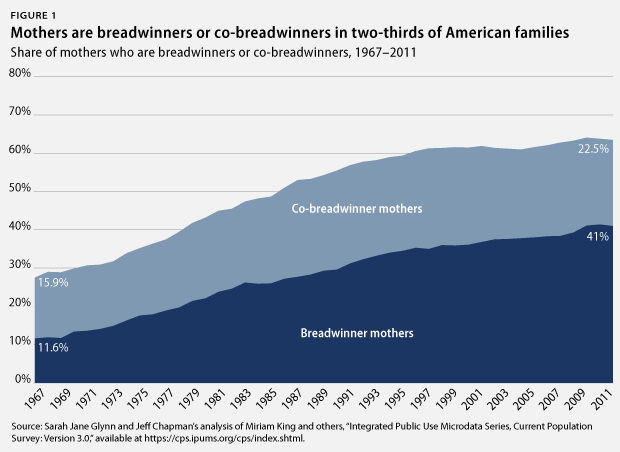
By addressing longstanding and ongoing gender disparities in pay and access to benefits; beefing up family supports such as universal child care, paid sick days, and paid family and medical leave; combating unemployment; and empowering employees to fight discrimination, policymakers could substantially and rapidly improve women’s lives and build family economic security.
We need to promote economic security for women and their families by ensuring that every woman can earn a fair day’s pay and by creating institutions that support families as they are, not as we imagine them to be. Here are 12 good policies that lawmakers can get started on today to better promote women’s economic security for themselves and their families.
Paid family and medical leave insurance
Women—and men—who work need time off for family reasons, but the United States is the only developed country that does not have national paid family and medical leave. California and New Jersey, however, are leading the way. Research on California’s program has found that it’s good for workers, good for families, and good for women. It also found that it has been a “non-event” for businesses, with 9 in 10 businesses reporting that the implementation of the program had no noticeable effect or a positive effect on productivity (89 percent), on profitability (91 percent), and on turnover (93 percent). A 2012 study from the Center for Women and Work at Rutgers University found that women who used paid leave were 39 percent less likely to receive public assistance and 40 percent less likely to receive food stamps in the year after a child’s birth.
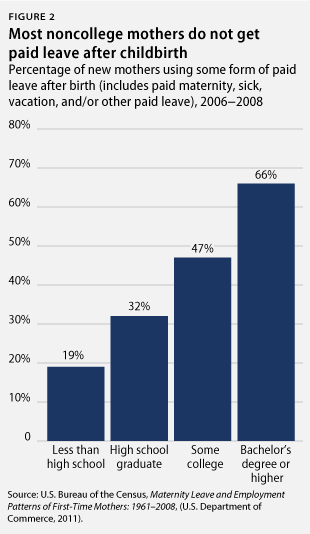
Congress can follow the lead of these states and introduce legislation fashioned after the Center for American Progress’s Social Security Cares model for a social insurance program that would allow workers to earn up to 12 weeks of paid leave after the birth of a child, the worker’s own serious illness, or the serious illness of a family member. In the meantime, Congress can also do more to help other states implement paid-leave-insurance programs by approving funds to help with startup and other costs.
Rehire teachers and public-sector workers laid off in the Great Recession and end the sequester
Many workers lost their jobs due to the Great Recession, and public-sector workers have been hit especially hard. (see Figure 3) This is a woman’s issue: 6 out of 10 state and local government employees and three out of four primary and secondary public-school teachers are women. Rehiring the teachers and other workers laid off during the recession would bring women back into solid, middle-class jobs while also helping to better educate young people. This is also critical for our economy more generally, as having an educated workforce is critical for economic growth.
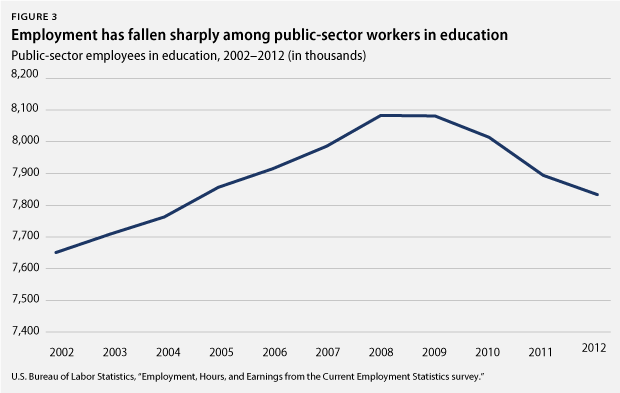
Sequestration, however, is the wrong way forward. Based on Congressional Budget Office estimates, the U.S. economy will create 142,000 fewer jobs each month for the rest of the year due to the combined effect of the payroll tax increase (800,000 fewer jobs in 2013) and sequestration (750,000 fewer jobs from March to December 2013). Most of these jobs will be lost in the second and third quarters of this year, so we are now only seeing the initial effects. We should aim for smart government rather than slash-and-burn policies that unfairly cut the jobs that women are more likely to hold and that
impair government effectiveness.
Promote pay equity
Even though 4 in 10 mothers are their family’s breadwinner, too many don’t earn a breadwinning wage. Women earn, on average, just 77 cents for every dollar that men earn, and this gap hasn’t budged in more than a decade. The gap in pay is even worse for women of color: Latinas earn 90 percent of what Latinos earn and about half of what white men earn. African American women also earn just 90 percent of what African American men earn and 69 percent of what white men earn. (see Figure 4)
Policymakers can take steps to ensure that every woman earns a fair day’s pay by passing the Paycheck Fairness Act. This law would hold discriminatory employers accountable and empower women to find out if they are being discriminated against and to subsequently negotiate for the salaries they deserve.
Ensure that women who want to join unions can do so
Women make up about half of all union workers, and union membership improves their wages and benefits. Unions enable workers to negotiate for fair wages and benefits and help ordinary citizens get involved in the political process, all of which also strengthen the middle class. Increasing unionization rates among home health aides and child care workers would be especially beneficial to women’s economic security since these jobs are not only growing rapidly but are female dominated and among the lowest-paid jobs in the U.S. economy.
To ensure that every woman who wants to form or join a union has the ability to do so, Congress should pass comprehensive labor-law reform that:
- Creates a fair process for workers to decide on union representation so that more workers are provided the right to organize and union coverage expands
- Establishes meaningful penalties and remedies for workers who are fired or discriminated against for exercising their right to organize
- Includes measures to promote productive bargaining between workers and companies
Congress should also make the right to join a union a civil right. This would give workers who are discriminated against for exercising their right to organize a private right to sue, just as workers have a right to sue if they face other forms of workplace discrimination.
Paid sick days for all workers
In the United States, unlike in every other developed country, workers do not have the right to stay home from work when they are sick. While many good employers do offer this benefit, women are less likely than men to hold the high-quality jobs that provide paid sick days. As a result, only half of women have access to this important benefit, which protects them from losing their jobs when they are ill.
Congress can close this gap immediately by passing the Healthy Families Act. This law would allow workers in firms with 15 or more employees to earn one hour of sick leave for every 30 hours worked—up to seven days of earned sick time per year.
Provide universal child care and pre-kindergarten
Most families do not have a full-time stay-at-home caregiver, which means that they need affordable and high-quality care options for their children while they are at work. The prohibitively high costs of private child care and the lack of quality, accessible public providers, however, means that parents are often left to choose between the lesser of two evils: low-quality care or forgoing needed wages to stay at home and care for a child themselves.

In addition to the positive long-term impacts that high-quality child care and early childhood education have on children and the economy, these programs also provide important benefits to working parents, especially working mothers. Increasing the share of child care costs offset by the federal tax credit to 50 percent and raising the amount that a parent can claim to $6,000 per child would help low-income working parents and mothers. We need to make these programs accessible by investing federal dollars to enable more lower-income families to afford child care for children ages 0–3 and to make preschool accessible to all 3- and 4-year-olds, as investments in these programs help cultivate our future workforce, secure long-term economic competitiveness, and develop our nation’s future leaders.
Fully implement the Affordable Care Act and expand Medicaid in the states
Both men and women need access to health care, but insurance companies in the individual market have a long history of discriminating against women, charging them more than men for the same benefits and refusing to cover maternity care in 88 percent of plans. The Affordable Care Act addresses those problems and ensures no-cost coverage for contraception and other preventive services for women. It also increases the affordability of health care coverage and will end discriminatory exclusions for the coverage of so-called pre-existing conditions such as breast cancer, domestic violence, and Cesarean sections. (see Figure 7)
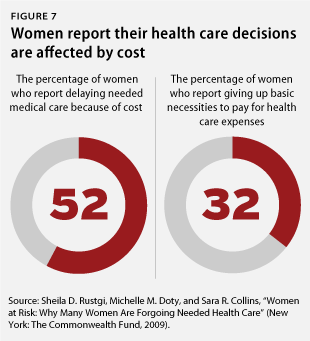
The Affordable Care Act also expanded eligibility for Medicaid for individuals and families living up to 138 percent of the federal poverty line. The Supreme Court decision upholding the health care law, however, allowed states to opt out of the expansion, leaving coverage uncertain for nearly 17 million Americans—including at least 7 million women. While many states have agreed to adopt the program, nearly 4 million women live in states that have yet to expand coverage. To make matters worse, these states also have the highest rates of uninsured women. States that have opted not to expand their programs or have yet to decide should act quickly and expand coverage to eligible low-income Americans.
Increase workplace flexibility and predictable scheduling
Women, like men, need the ability to have some control over their schedules, or at least have schedules that they can count on. Most women, however, don’t have that. Despite the fact that women spend twice as much time providing child care, they actually outnumber men—57 percent to 43 percent—in having no access to any form of paid leave or workplace flexibility. In addition, millions of women struggle with unpredictable schedules that wreak havoc on their child care arrangements and anything else they want to do with their time. (see Figure 8)
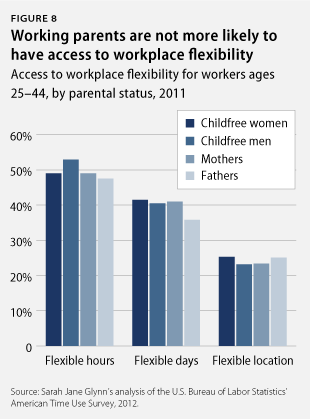
There are ways to remedy this problem that can give women the ability to have more control over their schedules. One way is to pass Rep. Carolyn Maloney’s (D-NY) Working Families Flexibility Act (H.R. 4106), which would grant employees the right to request flexibility and predictability in their schedules and help protect those who make such requests against employer retaliation. Rep. Maloney’s Working Families Flexibility Act is not to be confused with the Republican bill of the same name, which would give workers comp time that they could use about as easily as their frequent flyer miles, which are notoriously difficult to use when you want and need them.
Raise the minimum wage
For families to be economically secure, women need to earn a fair day’s pay. More than 60 percent of minimum-wage workers are women, yet making ends meet on today’s minimum wage is nearly impossible. A woman working full time, year round, and earning the minimum wage brings home just more than $15,000 a year, enough to cover only housing and transportation, depending on where she lives.
More than 13 million women would have higher wages if we increased the minimum wage to $9 an hour. (see Figure 9) This would have enormous benefits for families and our economy as a whole. If women’s earnings increased, they would also spend more, giving a much-needed boost to local businesses and employers.
Improve and enforce antidiscrimination laws
We may think that we have come a long way, but the reality is that discrimination still exists. In 2011 nearly one-third of the 100,000 employment-discrimination charges filed with the U.S. Equal Employment Opportunity Commission, or EEOC, involved allegations of sex discrimination. Women also filed the bulk of the largest category of charges: allegations of retaliation for complaining about discrimination.
Congress can address this by ensuring that enforcement agencies have the resources they need to uphold the law as vigorously as possible. Unfortunately, the sequester resulted in employee furloughs and approximately $20 million in cuts to the EEOC’s budget, which may lead to a 40 percent growth in the current backlog of workplace-discrimination cases. Congress can also take steps to pass laws to strengthen enforcement, such as the Paycheck Fairness Act and the Employment Non- Discrimination Act.
Ensure access to family-planning services
Having the ability to control the timing and spacing of pregnancy and childbirth is essential for women to be able to participate fully in education and paid employment. It is well documented that when the pill became widely available in the 1960s and 1970s, women joined the workforce in droves, becoming more economically independent and contributing more across every sector of our economy. But a recent study by the University of Michigan has put numbers to the narrative, estimating that the pill alone can account for 10 percent of the convergence of the gap between men and women’s salaries in the 1980s and 30 percent in the 1990s. The study also found that the younger women were when they obtained access to the pill, the more they earned over the course of their lifetimes.
Policymakers should:
- Protect access to family planning through Medicaid, which is the largest public provider for family-planning services.
- Increase funding for Title X family-planning services, which help support a vast network of family-planning providers nationwide and have faced significant cuts in recent years.
- Ensure compliance with implementation of the Affordable Care Act’s guarantee of no-cost coverage for all FDA-approved methods of contraception.
Strengthen Social Security and retirement plans
Social Security is key to women’s economic security in retirement, and it is especially important for widows, who rely on it for an average of eight years after their spouses have died. (see Figure 10) Since women earn less over the course of a lifetime, however, they receive less than men from Social Security, as well as from pension and 401(k) plans more generally.
Congress should reject any proposals to cut retiree benefits or privatize Social Security. Expanding access to employer-based retirement plans would also increase the likelihood of women having access to additional retirement income beyond Social Security benefits. This can be achieved through the development of the Secure, Accessible, Flexible, and Efficient Retirement Plan, which takes the best practices from traditional pensions and 401(k) plans, and by opening the federal Thrift Savings Plan, the 401(k) for federal employees, to nongovernmental workers.
Conclusion
The trends of the past half-century are unlikely to reverse. Women will continue to play an expanding role in our workplaces and homes, our economy, and our families. But until we craft policies aligned with this reality—policies that make it possible to be both a good mother and a good worker, policies that erase fears about whether a woman is being compensated fairly or whether she can afford basic health services—the United States will be at a competitive disadvantage.
Women make up half of the U.S. workforce, and the vast majority of U.S. women—81 percent—will become mothers by ages 40 to 44. Legislation that promotes women’s economic security helps not just women but also their families and children. The policies outlined above are investments in future generations, and they are ones we cannot afford to postpone any longer.
Heather Boushey is a Chief Economist with the Center for American Progress. Jane Farrell is a Research Assistant for Economic Policy at the Center.